Khan, W.U., Mahmood, A., Bozorgchenani, A. orcid.org/0000-0003-1360-6952 et al. (7 more authors) (2024) Opportunities for Intelligent Reflecting Surfaces in 6G Empowered V2X Communications. IEEE Internet of Things Magazine, 7 (6). pp. 72-79. ISSN 2576-3180
Abstract
The applications of upcoming sixth-generation (6G) empowered vehicle-to-everything (V2X) communications depend heavily on large-scale data exchange with high throughput and ultra-low latency to ensure system reliability and passenger safety. However, in urban and remote areas, signals can be easily blocked by various objects. Moreover, the propagation of signals with ultra-high frequencies, such as millimetre waves and terahertz communications, is severely affected by obstacles. To address these issues, the Intelligent Reflecting Surface (IRS), which consists of nearly passive elements, has gained popularity because of its ability to intelligently reconfigure signal propagation in an energy-efficient manner. Due to the promise of ease of deployment and low cost, IRS has been widely acknowledged as a key technology for both terrestrial and non-terrestrial networks to improve wireless coverage signal strength, physical layer security, positioning accuracy, and reduce latency. This article first describes the introduction of 6G empowered V2X communications and IRS technology. Then, it discusses different use case scenarios of IRS enabled V2X communications and reports recent advances in the existing literature. Next, it focuses our attention on the scenario of vehicular edge computing involving IRS enabled drone communications in order to reduce vehicle computational time via optimal computational and communications resource allocation. Finally, this article highlights current challenges and discusses future perspectives of IRS enabled V2X communications in order to improve current work and spark new ideas.
Metadata
| Item Type: | Article |
|---|---|
| Authors/Creators: |
|
| Copyright, Publisher and Additional Information: | © 2024 IEEE. Personal use of this material is permitted. Permission from IEEE must be obtained for all other uses, in any current or future media, including reprinting/republishing this material for advertising or promotional purposes, creating new collective works, for resale or redistribution to servers or lists, or reuse of any copyrighted component of this work in other works. |
| Dates: |
|
| Institution: | The University of Leeds |
| Academic Units: | The University of Leeds > Faculty of Engineering & Physical Sciences (Leeds) > School of Computing (Leeds) > Distributed Systems & Services |
| Depositing User: | Symplectic Publications |
| Date Deposited: | 27 Sep 2024 15:01 |
| Last Modified: | 05 Dec 2024 07:19 |
| Status: | Published |
| Publisher: | Institute of Electrical and Electronics Engineers |
| Identification Number: | 10.1109/iotm.001.2300096 |
| Sustainable Development Goals: | |
| Open Archives Initiative ID (OAI ID): | oai:eprints.whiterose.ac.uk:217673 |


 CORE (COnnecting REpositories)
CORE (COnnecting REpositories) CORE (COnnecting REpositories)
CORE (COnnecting REpositories)